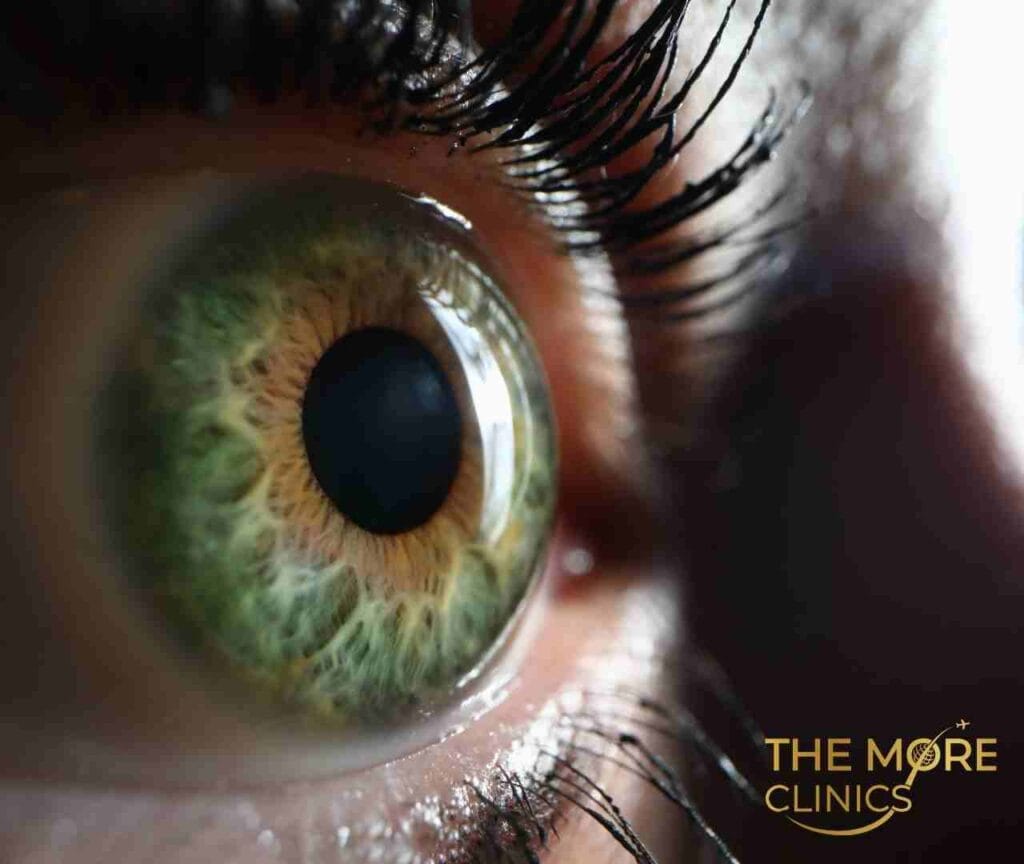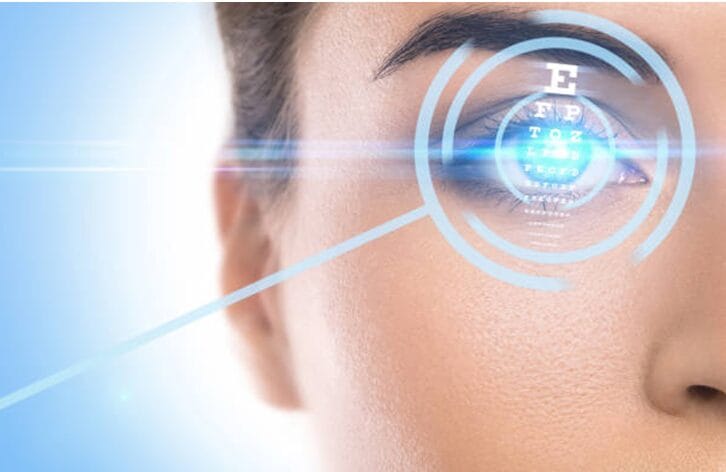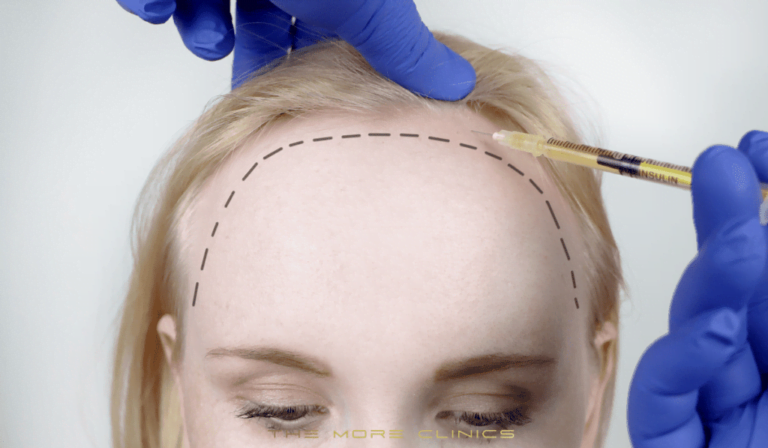Farsightedness (Hyperopia): A Comprehensive Guide
Farsightedness, or hyperopia, is a common vision condition that can affect individuals of all ages. It causes blurry close-up vision, making activities like reading difficult, and may also lead to headaches or eye strain. In this guide, we’ll explore everything you need to know about farsightedness, including its symptoms, causes, related refractive errors, and treatment options. We’ll also discuss advanced solutions like laser eye surgery for farsightedness, including affordable options available in destinations such as Turkey.

What is Farsightedness (Hyperopia)?
Farsightedness, or hyperopia, is a refractive error that occurs when the eye focuses light behind the retina instead of directly on it. This results in difficulty seeing nearby objects clearly, while distant objects may still appear sharp.
Farsightedness is not an eye diease, it is an eye focusing disorder.
It can occur in one or both eyes and is usually genetic. It often runs in families, with some people being more prone to it than others. Some people may develop farsightedness over time due to age-related changes, such as presbyopia (the loss of elasticity in the eye lens).

How common is Farsightedness?
Farsightedness is relatively common, affecting an estimated 5 to 10 percent of the U.S. population. It can occur at any age, though it is more commonly diagnosed in people over the age of 40. According to a study conducted by the National Eye Institute (NEI), roughly 8.4 million people in the United States aged 40 and above have hyperopia. Please refer to this source for further information.
Global estimates suggest that roughly 1 billion people, or about 1 in 7 individuals worldwide, are affected by this condition.
What are the Symptoms of Farsightedness (Hyperopia)?
Individuals with farsightedness may experience several symptoms. These include:
- Difficulty focusing on nearby objects
- Blurry vision, particularly when reading, sewing, or working at a computer
- Squinting to see clearly
- Eye strain, discomfort or headache after close-up work
- Burning or aching eyes
- General discomfort or headache after prolonged periods of focusing on a task
- In children, there might be an issue with academic performance due to difficulty seeing the blackboard or reading materials.
Again, it’s important to note that these symptoms can vary from person to person. If you’re experiencing any of these symptoms, it is recommended to consult with an eye care professional for a comprehensive eye examination.
What causes farsightedness (Hyperopia)?
Farsightedness, or hyperopia, is primarily caused by a mismatch in the eye’s physical length and its optical length. This mismatch can happen due to the following:
- Short Eyeball: This is the most common cause of farsightedness. When the eyeball is shorter than normal, light rays focus beyond the retina, leading to blurry images of close objects.
- Flat Cornea: The cornea’s curvature plays a significant role in focusing light onto the retina. A flatter cornea is not able to effectively focus the light, causing hyperopia.
- Lens Issues: If the lens inside the eye is not as powerful as it needs to be, light can be focused beyond the retina, causing farsightedness.
- Ageing: As we age, the eye’s lens loses its flexibility, making it harder to focus light on the retina, leading to problems such as presbyopia, which is a form of farsightedness.
Again, it’s important to note that these factors can vary from person to person, and having one or more of these does not guarantee that one will develop hyperopia.
What are the Treatment Options for Farsightedness (Hyperopia)?
Several treatment options are available to correct farsightedness, including:
Eyeglasses: Prescription lenses can help focus light correctly on the retina, improving vision for close-up tasks.
Contact lenses: Contacts provide an alternative to glasses for correcting farsightedness and may offer better peripheral vision.
Laser eye surgery Procedures such as: LASIK, PRK, RELEX SMILE or Lens Replacement Surgery can reshape the cornea, reducing or eliminating the need for corrective eyewear.
Laser Eye Surgery for Farsightedness: PRK vs LASIK vs SMILE
Three common laser eye surgery procedures used to correct farsightedness are LASIK, PRK, and SMILE. While all three surgeries reshape the cornea using advanced laser technology, they differ in technique and recovery.

PRK (Photorefractive Keratectomy):
- Uses an excimer laser to reshape the cornea by removing tissue from the surface.
- May be recommended for individuals with thin corneas or other issues that make LASIK unsuitable.
- Recovery time can take up to several weeks.
LASIK (Laser-assisted In-situ Keratomileusis): If you are curious how can laser eye surgery fix farsightedness, read our Guide.
- Uses a femtosecond laser to create a flap in the cornea, which is reshaped using an excimer laser.
- The flap is then placed back down, creating a smoother surface for light to pass through.
- Recovery time can be as little as a few days.
SMILE (Small Incision Lenticule Extraction):
- A minimally invasive procedure that reshapes the cornea by removing a small piece of tissue (lenticule) through a keyhole incision.
- No corneal flap is created, which may reduce the risk of complications and dry eye symptoms.
- Recovery time is typically short, and the procedure is less invasive than LASIK or PRK.
Ultimately, the choice between PRK, LASIK, and SMILE depends on factors such as eye health, prescription strength, and personal preference. Consulting with a qualified eye doctor is essential to determine the best procedure for your needs.
Cost of Laser Eye Surgery for Farsightedness
The cost of laser eye surgery for farsightedness (hyperopia) can vary depending on several factors, including the country where the procedure is performed. Here is a general overview of the estimated costs for LASIK and PRK in Germany, the UK, and Turkey:
Here is a cost comparison table for laser eye surgery for farsightedness (hyperopia), including LASIK, SMILE, and PRK, in the USA, Canada, and Turkey:
| Procedure | USA (Per Eye) | Canada (Per Eye) | Turkey (Per Eye) |
|---|---|---|---|
| LASIK | $2,000 – $3,000 | $1,900 – $2,990 | $800 – $1,300 |
| SMILE | $2,500 – $4,000 | $2,000 – $3,500 | $1,000 – $1,500 |
| PRK | $1,800 – $3,000 | $1,500 – $2,800 | $750 – $1,250 |
Notes:
- USA: Prices vary based on technology and the surgeon’s experience. Advanced techniques like wavefront-guided LASIK can increase the cost.
- Canada: Costs are slightly lower compared to the USA, with similar variations depending on the clinic and technology used.
- Turkey: Turkey is a popular destination for medical tourism, offering significantly lower prices due to reduced overhead costs while maintaining high-quality care. Additional packages may include accommodations and transfers.
If you’re considering these laser eye surgery for farsightedness, ensure you consult an experienced ophthalmologist and factor in travel costs for international options.
Get your All-Inclusive Laser Eye Surgery Turkey Package with 30% Off!
Frequently Asked Questions
Q: Is Farsightedness (Hyperopia) Contagious?
A: No, farsightedness is not contagious and cannot be spread from person to person. It is a refractive error that can occur in one or both eyes, usually as a result of genetic factors.
Q: Can farsightedness (hyperopia) be corrected without surgery?
A: Yes, farsightedness can usually be corrected with eyeglasses or contact lenses. Laser eye surgery for farsightedness procedures are also available for more severe cases of hyperopia, but they are typically only recommended if other treatments do not work.
Q: Does Laser Eye Surgery Correct Farsightedness permanent or temporary?
A: Laser eye surgery permanently reshapes the cornea, which can provide long-lasting results in most cases. However, some individuals may experience a regression of their vision over time, which may require an enhancement procedure to maintain clear vision. It’s important to follow your eye doctor’s post-operative instructions carefully and attend regular check-ups to ensure the best possible outcome.
Q: What lifestyle changes can I make to reduce the risk of developing farsightedness (hyperopia)?
A: Although the exact cause of farsightedness is not known, some lifestyle changes can help reduce the risk. These include eating a healthy diet rich in antioxidants, wearing sunglasses when outdoors to protect the eyes from ultraviolet radiation, and taking regular breaks while working or reading to reduce eye strain. Additionally, if you have a family history of farsightedness, it’s important to get your eyes checked regularly and follow your eye doctor’s advice.
Q: Are there any risks associated with laser eye surgery for farsightedness (hyperopia)?
A: Yes, as with any surgery, there are some risks associated with laser eye surgery for farsightedness. These include infection, dry eyes, undercorrection and over-correction of the vision, glare or halos around lights, double vision, and increased sensitivity to light. Thus, it’s important to discuss any potential benefits and risks with your eye doctor before deciding on a course of treatment.
Q: Is farsightedness (hyperopia) more common in men or women?
A: Farsightedness is equally common in both men and women, but it tends to become more pronounced with age for both genders. Additionally, certain ethnicities have been found to be more likely to develop hyperopia, such as Caucasians and Africans.
Q: Can Laser Eye Surgery Correct Farsightedness and Nearsightedness?
A: Yes, laser eye surgery can correct both farsightedness (hyperopia) and nearsightedness (myopia). For farsightedness, laser eye surgery aims to reshape the cornea to improve the focusing power of the eye. The procedure involves removing tissue to steepen the cornea, allowing light rays to focus directly on the retina. Similarly, for nearsightedness, laser eye surgery adjusts the shape of the cornea to flatten it, enabling light to focus properly on the retina.
Q: Will my vision improve with age if I’m farsighted?
A: Unfortunately, the opposite is true for people who are naturally farsighted. Over time, the refractive error often worsens due to normal age-related changes in the eye’s structure. However, this can be corrected with eyeglasses or contact lenses, and in some cases, laser eye surgery.
Last Words from the More Clinics
Understanding the symptoms, causes, related refractive errors, and treatment options for nearsightedness (myopia) is crucial for maintaining good eye health and preventing further vision problems. Regular eye exams and appropriate treatment can help ensure clear vision and overall well-being. Always consult with an eye care professional to discuss your specific needs and determine the most suitable treatment plan for you.
At The More Clinics Turkey, we are committed to providing the highest quality of care and services to help you regain your vision. Our experienced team of doctors will work with you to create a personalized treatment plan that meets your needs and goals for clearer vision. Contact us today to learn more about our services and get started on your journey toward better vision!
GET A FREE CONSULTATION!
Let’s Start Planning Your Treatment %100 Guarantee Results.

Written by The More Editorial Team and Medically Reviewed by Op.Dr.İbrahim Kaya who specialized on Eye Surgery, Retinal Surgery and Optalmology.






